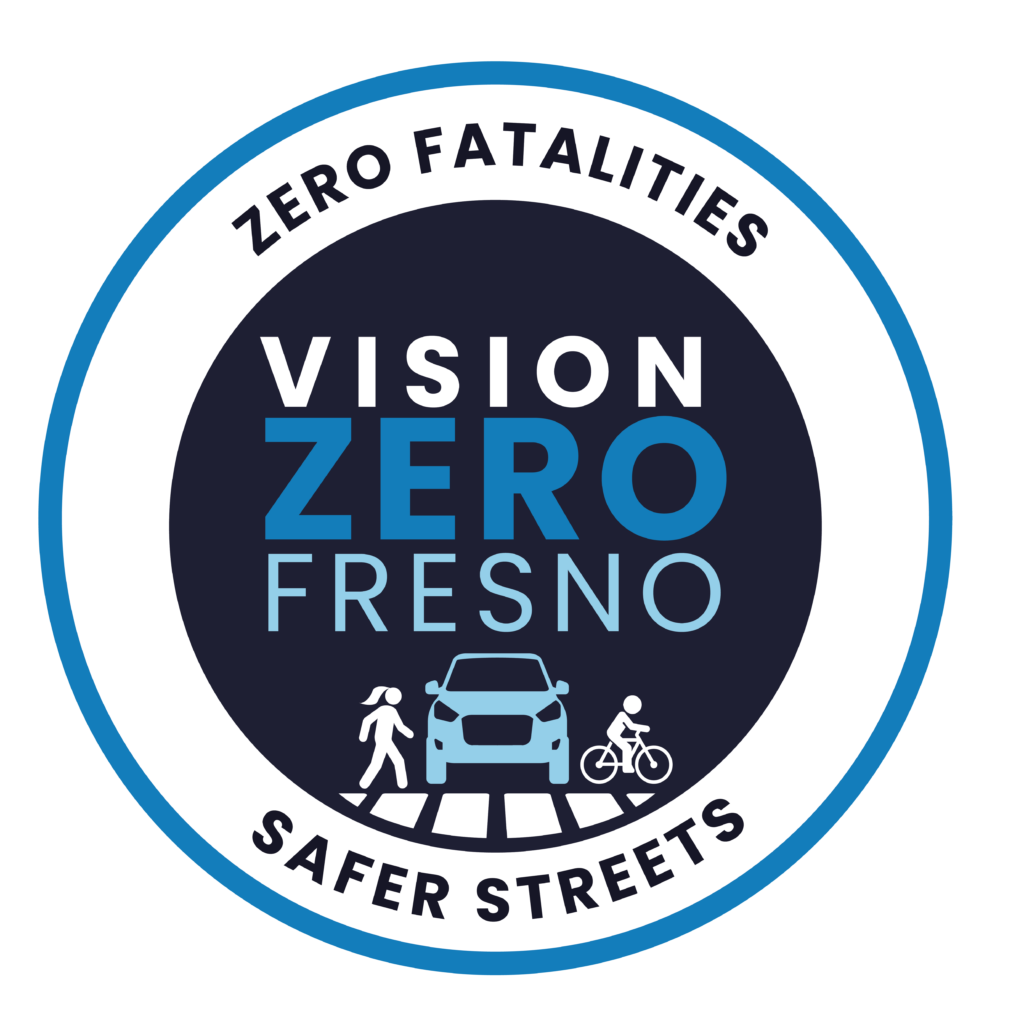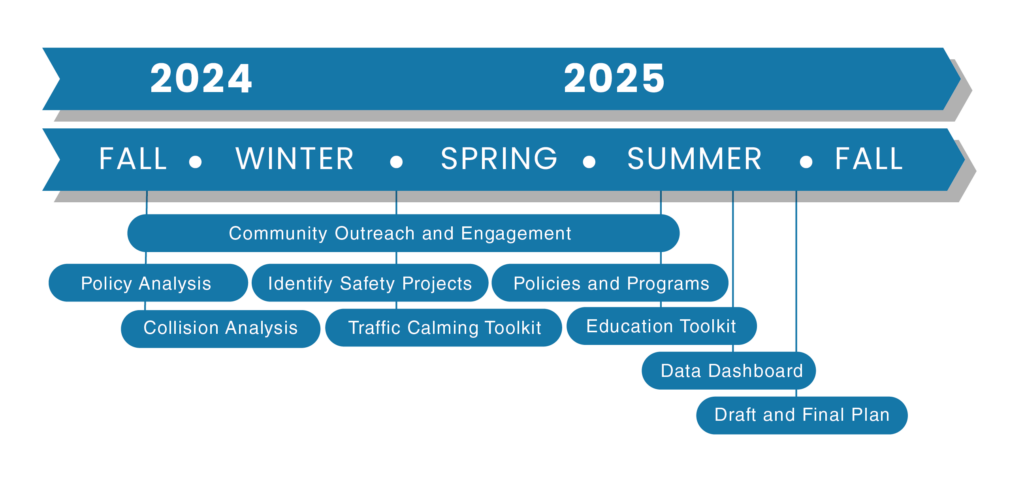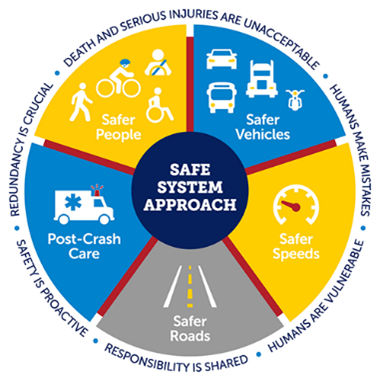

Vision Zero Action Plan
Zero Fatalities, Safe Streets
Project Overview
Overview
Between 2018 and 2022, there were almost 500 fatal or serious injury crashes in Fresno. On average, one person lost their life every seven days as a result of a traffic collision on Fresno roadways. The consequences of crashes are particularly severe for people walking; 127 pedestrians died from crashes between 2018 and 2022—accounting for half of all fatalities.
To prevent further loss of life in Fresno, significant action is needed to achieve Safer People, Safer Speeds, Safer Roads, and Safer Vehicles—the Safe System Approach—through responsive policies, programs, and roadway designs.
Members of the Fresno City Council have indicated that roadway safety is a top priority for them and their constituents. The Fresno Vision Zero Action Plan (Plan) is crucial to acting on the City’s commitments to systemic change leading to the elimination of traffic fatalities and serious injuries while increasing health, safety, and equitable mobility for all. The Plan will outline a strategic planning framework to prioritize and implement safety enhancements that most effectively improve safety for all users as a first step towards the aspirational goal of eliminating traffic deaths. The City of Fresno acknowledges that achieving this goal will require a commitment to a fundamental shift in the day-to-day “business” of transportation in the City of Fresno.
Take the Vision Zero Survey
Between 2018 and 2022, there were almost 500 fatal or serious injury crashes in Fresno. On average, one person lost their life every seven days as a result of a traffic collision on Fresno roadways. The consequences of crashes are particularly severe for people walking: 127 pedestrians died from crashes between 2018 and 2022, accounting for half of all fatalities.
To prevent further loss of life in Fresno, significant action is needed. The City of Fresno is undertaking the Vision Zero Action Plan to identify systemic changes that will help us eliminate traffic fatalities and serious injuries and increase health, safety, and equitable mobility for all.
Please take a few minutes to share your thoughts, concerns, and suggestions about traffic safety in Fresno. All answers are confidential.
Project Timeline

What / Why Vision Zero?
Vision Zero is a strategy focused on eliminating traffic fatalities and severe injuries, while increasing safe, healthy, and equitable mobility for all.
According to the Vision Zero Network, over 40,000 people are killed each year on American streets, and hundreds of thousands more are injured. Every fatal or serious collision is not just a statistic – they are our friends, family, and neighbors. A Vision Zero approach sees these traffic deaths as preventable.
What is the Vision Zero Action Plan?
The Vision Zero Action Plan will focus Fresno’s efforts to eliminate all traffic fatalities and severe injuries while promoting safe, healthy, and equitable mobility for all road users.
Rooted in the Safe System Approach, the plan will emphasize that human life and health are paramount, and the transportation system must be designed to accommodate human error and vulnerability.
The Fresno Vision Zero Action Plan will:
- The Fresno Vision Zero Action Plan will:
- Analyze crash data to understand when, where, and why crashes are happening
- Engage community members, stakeholders, and decision makers to collect input, provide feedback, and inform the planning process
- Identify strategies, projects, priorities, and policy changes that aim to eliminate fatal and serious crashes on Fresno streets
- Prepare the City of Fresno to apply for future funding opportunities to implement transportation safety improvements
What is the Safe System Approach?
The Safe System Approach—adopted by the United States Department of Transportation as the guiding model to address roadway safety—is a human-centered approach that begins with the ethical belief that no one should be killed or seriously injured in traffic crashes.
The Safe System Approach employs a holistic method to road safety, acknowledging that there is a shared responsibility between those that design, build, operate, and use the road system. It aims to eliminate crashes that result in fatal and severe injuries by preparing for human mistakes and designing roadways to reduce the severity of crashes that do occur.

6 Principles make up the Safe System Approach, including:
Death and Serious Injuries are Unacceptable
A Safe System Approach prioritizes the elimination of crashes that result in death and serious injuries.
Humans Make Mistakes
People will inevitably make mistakes and decisions that can lead or contribute to crashes, but the transportation system can be designed and operated to accommodate certain types and levels of human mistakes, avoiding death and serious injuries when a crash occurs.
Responsibility is Shared
All stakeholders—including government at all levels, industry, non-profit/advocacy, researchers, and the general public—are vital to preventing fatalities and serious injuries on our roadways.
Safety is Proactive
Proactive tools should be used to identify and address safety issues in the transportation system, rather than waiting for crashes to occur and reacting afterwards.
Redundancy is Crucial
Reducing risks requires that all parts of the transportation system be strengthened, so that if one part fails, the other parts still protect people.
The 5 objectives of a Safe System Approach include:
Safer People
Encourage safe, responsible driving and behavior by people who use our roads and create conditions that prioritize their ability to reach their destination unharmed.
Safer Roads
Design roadway environments to mitigate human mistakes and account for injury tolerances, to encourage safe behaviors, and to facilitate safe travel by the most vulnerable users.
Safer Vehicles
Expand the availability of vehicle systems and features that help to prevent crashes and minimize the impact of crashes on both occupants and non-occupants.
Safer Speeds
Promote safer speeds in all roadway environments through a combination of thoughtful, equitable, context-appropriate roadway design, appropriate speed-limit setting, targeted education, outreach campaigns, and enforcement.
Post-Crash Care
Enhance the survivability of crashes through expedient access to emergency medical care, while creating a safe working environment for vital first responders and preventing secondary crashes through robust traffic incident management practices.

Get Involved
Check back for upcoming events and other opportunities to get involved in the Vision Zero Action Plan!
The Plan aims to draw from perspectives and people’s experiences throughout the entire city of Fresno. In addition to community member involvement in the Plan, a Vision Zero Task Force and Stakeholder Group will convene regularly throughout plan development to help guide the planning process.
Vision Zero Taskforce
The Vision Zero Taskforce is comprised of key decision-makers. The Task Force will build a common understanding of safety-related challenges, establish general improvement priorities, and provide input on locations and context appropriate strategies. Four Taskforce meetings will be held throughout the project process.
Stakeholder Group
The Stakeholder Group is comprised of community-based organizations (CBOs) and community advocates. Stakeholder group convenings will be used to build project buy-in, get feedback on outreach and engagement efforts, present high-level findings, and disseminate project information. Throughout the project, the Stakeholder Group will help distribute project information and publicize engagement opportunities.
PROVIDE FEEDBACK
Let us know if you have any comments or suggestions about the project by filling the feedback form below.
CONTACT
Fore more information or to share your input,
contact: Andreina Aguilar at [email protected]